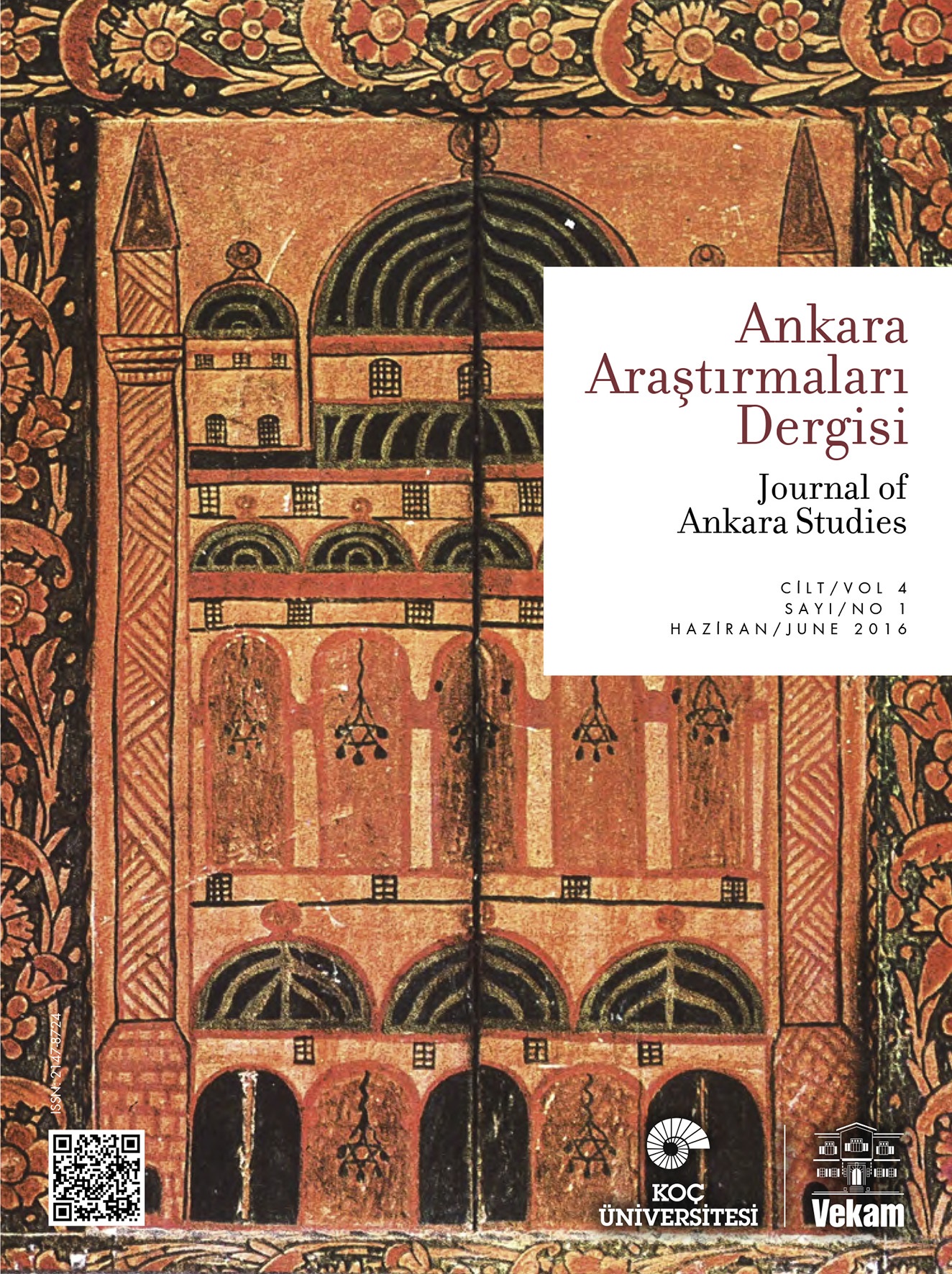Volume: 4 Issue: 1 - 2016
| 1. | From the Editor Page I |
| RESEARCH ARTICLES | |
| 2. | Migrations to Ankara by Railway and Settlement Policy (1890-1910) İhsan Seddar Kaynar, Murat Koraltürk doi: 10.5505/jas.2016.83703 Pages 1 - 12 The Anatolian Railway began running between Ankara and Haydarpaşa in Istanbul via İzmit and Eskişehir in early 1893, making transportation from Istanbul to the interior of Anatolia very easy. In late 1892, before the railroad was opened, policymakers prepared official reports on the resettlement of migrants along the rail route from Eskişehir to Ankara; and made regulations accordingly. This studyexamines the route of this migration, which first run to the port of İzmit by sea and then reached Ankara by rail. This article discusses the politics of resettlement and the conditions of migrants settled on the railway route during the twenty-year period between 1890 and 1910, when the Balkan Wars provoked mass migration to Anatolia from the Balkans. It analyzes the locations of the new settlements, the conditions in newly founded villages, and the habitability of the wasteland along the railway route. Daily rations, state aid for housing, types of production, agricultural styles, and the position of artisans will also be considered. |
| 3. | A Painted House In Ankara: Dedebayrak House Muzaffer Karaaslan doi: 10.5505/jas.2016.46330 Pages 13 - 22 The conservative family lifestyle in the Ottoman State affected the ways that houses were planned and decorated. Different decorative programs emerged with major differences in each period. New techniques and styles began to be seen in the 18th century thanks to the influence of the West. This article will focus on the decoration of Dedebayrak House in Ankara. Decoration in the architecture found within the boundaries of Ankara consist mostly of geometrical or floral decorations and various inscriptions. The Dedebayrak House not only has these kind of decorations, but also it has these decorations in its architectural descriptions, so it makes this house the only one to have survived in Ankara. Moreover, this building is especially important as the décor included work belonging to Nakkaş Mustafa. However, these decorative features do not remain today. The situation in Turkey is such that architecture is not conserved, which leads to many historically important buildings vanishing. Neither local authorities, nor the owner of these buildings look after these buildings properly, leading their specific historical features to be lost. This situation both damages the urban fabric and harms the historical heritage of the city. Therefore, decorative features in the building will be analysed both on their own and compared to other buildings in Ankara in order to create an overall picture. |
| 4. | An Example of a Gentrification: Unintended Consequences of an in Situ Rehabilitation Project in Ankara Reyhan Varlı Görk, Helga Rittersberger Tılıç doi: 10.5505/jas.2016.72691 Pages 23 - 43 This article is about an early example of gentrification processes in Ankara, the capital of Turkey. A unique form of the gentrification process is examined using a case study of a small inner-city neighborhood on Koza Street through the monitoring of the area between 1998 and 2016, and giving voice to both the gentrifiers and gentrified. Almost ninety percent of the population in the area was displaced despite the inclusionary principles of an in situ Rehabilitation Project which has led to a large scale transformation of the physical space of the street. The study includes four field studies conducted at different time intervals (1998, 2001, 2004, 2009) and a follow-up visit (2016) to the neighborhood, to critically assess the progression of gentrification in Turkey through its phases. Even though gentrification usually refers to the middle class invasion of urban land originally inhabited by the less privileged, our case reveals the effects of successive modes of a gentrification process which starts as an in situ rehabilitation project of a squatter prevention area initiated by a social democratic municipality with the “participation of local groups”, and turns into “gentrification by choice” in the successive years in the shadow of “Third Way” values. What is currently happening could be regarded as “gentrification by force” following urban renewal. In our case, however, the line between the two major components of gentrification, i.e., the “gentrifier” and the “gentrified”, seems to have become ambiguous, which calls for a further analysis of Turkey’s unique political and spatial dynamics. |
| 5. | Changing Cultural Spaces, Transformation of the Traditions: Hıdırellez Celebrations held in Ankara and Hamamönü Hıdırellez Festivals Selcan Gürçayır Teke doi: 10.5505/jas.2016.70299 Pages 44 - 59 Hıdırellez festival, one of the rituals that hails the start of summer, is celebrated widely across Anatolia. The belief thatwishes for the future will come true if certain actions are performed at Hıdırellez festival, may be seen as the basic motivation behind this ritual and the transmission of this tradition from generation to generation. Many practices at Hıdırellez are related to nature. The space to celebrate Hıdırellez is of the utmost importance due to the context of the ritual. There are many cultural spaces in Anatolia assigned for the celebration of Hıdırellez; these are selected based on the belief that they have been visited by Hızır. The cultural transmission of Hıdırellez celebrations is being hindered among an urbanizing population due to fewnew spaces being planned for them and a lack of protection for the existing spaces. This article focuses on the Hıdırellez festival spaces and the necessity of moving these spaces into cities in order to maintain the tradition. This article evaluates the basic importance of these spaces from the standpoint of sustainability and the formation of the tradition using the Hamamönü Hıdırellez festival, which is celebrated in Ankara. It discusses the variations of the participant profiles at the Sixth Hamamönü Hıdırellez festival, to be held in Ankara this year and the how their expectations have been shaped based on changing spaces. It concludes that besides the dimension of belief in the rituals, the dimension of entertainment is also prominent for participants at the Hamamönü Hıdırellez festival, and that various Hıdırellez traditions have found their way into popular culture. |
| OPINION ARTICLE | |
| 6. | Bibliography of Rusûhî İsmâil Ankaravî Ömer Gök doi: 10.5505/jas.2016.08370 Pages 60 - 66 When we look at the history of Turkish civilization, it comes to our attention that certain authors have produced enormous canons of work. One of these particularly prolific authors is İsmâil Ankaravî. Also known by his pen name Rusûhî, İsmâil Ankaravî Effendi was initiated into the Mawlawi Order, becoming the sheikh of the Galata Mawlawi House for a long time and one of the important names in this tradition. In particular, he received the title of “Hazret-i Şârih” for his commentary on Masnavi, which became widely known. However, he also wrote many other works. This study aims to present past academic research (books, dissertations, articles, papers etc.) on Ankaravî’s works as a whole in order to help future researchers. |
| 7. | Large-Scale Change in the Capital Ankara after the Declaration of the Republic: The Construction of Modern Life and Modern Spaces Adile Nuray Bayraktar doi: 10.5505/jas.2016.69875 Pages 67 - 80 Ankara, which is nowadays subject to criticism and debate due to large-scale changes in daily and spatial life, also witnessed considerable changes in the aftermath of the establishment of the Turkish Republic. Obviously, the reasons for these latter changes were based on the demand that the city and its dwellers have “modern spaces” in which to experience “a modern life”. New activities made available by such modernization attempts not only altered daily life routines in Ankara but also rapidly changed the face of the city through the construction of new spaces to accommodate these activities. This article delves into the changes that occured in Ankara at this time, with particular focus on the spaces which have retained their significance in the public perception, as well as on these newly emerging activities in daily life. It also proposes a reading of the life and spaces of the Republican period touching upon the institutional structures which were established during its construction. |













